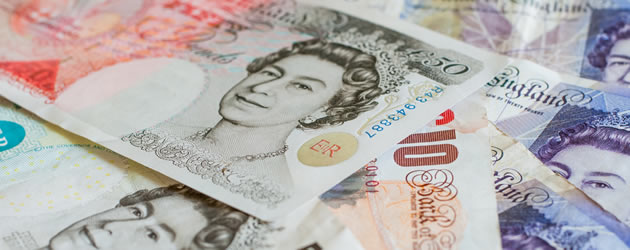- Pound falls back ahead of the weekend – Profit taking erodes gains made on stronger UK retail sales
- ECB less dovish than expected – Euro strengthened by reduced likelihood of additional easing measures
- Disappointing Philadelphia Fed Index dented US Dollar – Bullish run interrupted by manufacturing sector weakness
- GBP/EUR exchange rate forecast to benefit from Greek worries – Concerns mount over future of bailout
Pound (GBP) Extended Downtrend after BoE Commentary
The Pound (GBP) extended its slump against rivals towards the end of Friday’s European session, in spite of a better-than-expected CBI Total Orders Trend figure. Investors remained discouraged by the dovishness of Bank of England (BoE) policymaker Jan Vlieghe, allowing the Euro (EUR) and US Dollar (USD) to strengthen their gains against the weakened currency.
Earlier…
Profit Taking Weakened Pound Sterling (GBP) Following Bullish Run
Demand for the Pound (GBP) remained bullish on Thursday thanks to the UK’s April Retail Sales figures. Consumer spending strongly increased by 4.5% on the year, as opposed to a forecast result of 2.5%, suggesting that confidence within the domestic economy had not been overly weakened by referendum uncertainty. As this followed up an encouraging poll from IPSOS MORI, which gave the ‘Remain’ campaign a strong lead, investors naturally flocked back into Sterling, bolstering the currency across the board.
However, with Friday’s CBI Total Orders Trend report expected to show weakness, the Pound was unable to maintain its heightened appeal. Consequently, markets engaged in a round of profit taking, pushing the currency back down in anticipation of further ‘Brexit’-based volatility. Dovish commentary from Bank of England (BoE) policymaker Jan Vlieghe did not do anything to help confidence, as he suggested that interest rates might have to be cut even in the event of the UK voting to remain within the EU.
ECB Reluctance to Ease Policy Further Bolstered Euro (EUR) Exchange Rate
The appeal of the Euro (EUR) recovered somewhat in the wake of the account of the European Central Bank’s (ECB) April policy meeting. While there were concerns that the central bank could be looking to implement additional loosening measures, the tone of comments generally eased these worries. Policymakers were found to be in more of a ‘wait and see’ mode, relatively content to hold off and assess the impact of March’s volley of easing measures for the time being. As this seemed to indicate that the ECB will not engage in further monetary loosening in the near future the common currency strengthened against rivals.
A sharp strengthening in the Eurozone Current Account added further support to the Euro ahead of the weekend, as the surplus rose from 19.2 billion to 27.3 billion Euros in March. However, the International Monetary Fund (IMF) reiterated that it will not continue to support the Greek bailout unless greater debt relief measures are agreed, a prospect that weighed on the single currency. As the Greek parliament will also vote on the latest bill of creditor-mandated austerity measures over the weekend, concerns over the future of the bailout are likely to rise over the coming days.
US Dollar (USD) Volatile as Fed Hike Bets Dented by Weak Manufacturing Data
Investors were prompted to pile into the ‘Greenback’ (USD), meanwhile, after the Federal Open Market Committee (FOMC) April meeting minutes indicated that an interest rate rise could come as soon as June. As markets had anticipated a slightly less hawkish message, this prompted a sharp scramble to re-price the odds of an imminent hike, although the impact on the Pound Sterling to US Dollar (GBP/USD) exchange rate was relatively muted. There were still some doubts that the Fed could pull the trigger so soon, given the proximity to the UK’s EU referendum, as researchers at Goldman Sachs noted:
‘Normalizing policy, given that USD could appreciate a lot, is difficult for the Fed to do. Managing that process makes the Fed volatile and complicated, not dovish.’
A weaker-than-forecast Philadelphia Fed Index also decreased bets of a June rate hike, as it unexpectedly dipped from -1.6 to -1.8 in May. This softer showing does not seem to bode well for other upcoming manufacturing surveys, reigniting worries over the robustness of the sector and the wider US economy. Should Friday’s Existing Home Sales also demonstrate weakness then the US Dollar is expected to retreat against rivals, increasing doubts that the Fed will actually raise interest rates in the near future.
Current GBP, EUR, USD Exchange Rates
At the time of writing, the Pound Sterling to Euro (GBP/EUR) exchange rate was slumped in the region of 1.2976, while the Pound Sterling to US Dollar (GBP/USD) pairing was trending lower around 1.4564. Meanwhile, the Euro to US Dollar (EUR/USD) exchange rate was making gains at 1.1224.



